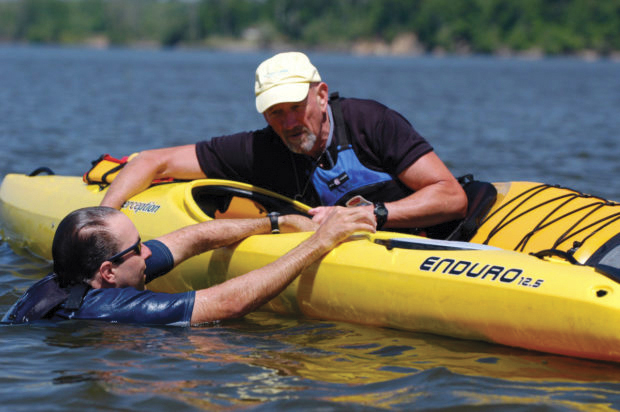National Park increases water-safety awareness
By Jacob Wheeler
Current Contributor
Last June 22, before Scott Tucker had finished his first week as the new superintendent at Sleeping Bear Dunes National Lakeshore, a vacationer drowned while snorkeling in Loon Lake, near the Platte River. Two weeks later, an 81-year-old man from southeast Michigan perished in Big Glen Lake when his boat drifted away while he was swimming. And on September 5, a 21-year-old died when his kayak capsized near Platte Bay in Lake Michigan waters.
Three drowning deaths in or near our National Lakeshore within less than three months last summer season. (Just recently, on June 11 of this year, another drowning death took place, this time in West Grand Traverse Bay—a flipped canoe sent two teenagers into the water, without life jackets.)
National Park policy stipulates that visitors are responsible for their own safety. But when something goes wrong, Sleeping Bear Dunes staff, first responders, and local law enforcement respond.
“Are we giving people as much water-safety training as we should?” Tucker asked himself.
Doing Something About It
Drowning is the number one cause of death within our National Parks. Nationwide, 10 people each day die from drowning, and two of those 10 are children under the age of 14, according to the U.S. Centers for Disease Control (CDC).
Between 2010 and 2016, 537 people drowned in the Great Lakes. Data collected by the Great Lakes Surf Rescue Project (GLSRP) counted 46 drowning deaths in Lake Michigan during 2016 alone.
GLSRP executive director Dave Benjamin attributes the increase in water tragedies to hotter summers and longer seasons, which brings more people into Lake Michigan waters. If the weather forecast for this summer holds, Benjamin adds, this could be another hot one, with more people going to the beach.
But he resists the temptation to characterize drowning deaths as a new problem.
“Drownings in the Great Lakes have always been a huge problem,” he says. “We just didn’t have a way to collect the data before. Now, because of the internet, because of Google news alerts, the drownings are more noticed.”
This challenge prompted our National Lakeshore staff to facilitate a first-ever “Splash Into Summer: Water Adventure Expo” earlier this month at Platte Point at the end of Lake Michigan Road, on the afternoon of Saturday, June 17. The educational event included water-play safety demonstrations, skills practice, and exhibits. The expo was designed to appeal to anyone who likes to swim or paddle in rivers, inland lakes, or Lake Michigan. Kayak and stand-up paddleboard (SUP) demonstrations, mock capsize/self-rescue exercises, and life-jacket-fittings were also offered. Stations were set up for weather and rip-current recognition, gear checklists, and drowning survival strategies. Still, the expo managed to be lighthearted, too, featuring face-painting and scavenger hunts for kids, with food trucks on site.
“As the water warms up and becomes more inviting in early summer, this event [was] a great opportunity to develop skills and remind everyone about water safety and the importance of wearing a life jacket,” Tucker says. “It is essential to know how to respond if you find yourself in an unplanned, out-of-boat experience or a rip current.”
In addition to the expo, which had about 300 people in attendance, the Sleeping Bear Dunes National Lakeshore is also hiring a preventative search and rescue intern this year. This individual will visit popular sites and talk to visitors about safe practices on the water.
Merrith Baughman, chief of interpretation and visitor services for Sleeping Bear Dunes, hopes that there will be another event next year. She says that most of the partners—including the National Park, GLRSP, the Michigan Department of Natural Resources (DNR), Benzie County Emergency Medical Services, the Coast Guard, Paul Oliver Memorial Hospital, and others—attended a post-meeting, and all had great things to say about the event. For the event to happen again, Baughman says, it will depend on resources and staff time that are made available next year.
Bridging The Disconnect
In 2016, the World Health Organization noted that drownings continue to be a neglected public health issue worldwide. But the resources allocated by governments have not fit the scope of the problem, according to GLRSP’s Dave Benjamin.
For instance, the U.S. government spent millions to combat the Zika virus—and media told countless horror stories of the mosquito-born disease creeping northward—but drowning deaths have not prompted a national call to action. Meanwhile, 10 Americans each day drown.
“There’s a huge disconnect,” Benjamin says.
GLSRP also warns that knowing how to swim should not be interpreted as a cure to prevent drowning.
“Knowing how to swim gives a false sense of security,” Benjamin adds. “When we look at the statistics, two-thirds of all drowning victims are good swimmers, who often over-estimate their abilities.”
Furthermore, when children know how to swim, it tends to reduce parental supervision.
“What we say is, ‘Everyone knows how to run, but not everyone can run a marathon’,” Benjamin says. “If you’re in water over your head, and you exhaust your energy, you could drown.”
According to GLSRP, a whopping 54 percent of Americans do not have basic swimming abilities to save their own lives in a water emergency. When people were tested on five basic skills—being able to resurface, treading water, turning around 360 degrees in the water, swimming at least 25 yards, and climbing out of water without assistance—more than half could not do it.
“People just assume that going to the beach is like going to the pool,” Benjamin says. “So if we put 1,000 people on the beach, 540 of them don’t have the ability to save themselves… Then you add winds, water currents, and cold water fluctuations.”
Jacob Wheeler is a former editor of The Betsie Current. A version of this story first published in our sister publication, the Glen Arbor Sun, where Wheeler still serves as editor.




